
 Map of the area.
Map of the area.
Padre Pio 1903-1914, age 16-27
Preparation to priesthood

![]() The mountainside village of Morcone.
The mountainside village of Morcone.
 Map of the area.
Map of the area.
On January 6, 1903, Francesco left home for
Morcone, to begin the novitiate in
the Capuchin’s Order. After the Mass of the Epiphany he went home so say good
bay to his parents, brothers, sisters, relatives and neighbors.[1]
Leaving his world was very hard for Francesco: “It was a very painful
excruciating agonizing detachment.”[2]
His mom gave him a Rosary (still preserved) and said: "My son, Saint Francis has
called you, and you must go. Pray many Rosaries!"[3]
[4]
 The convent as it was when Francesco Forgione entered the
novitiate.
The convent as it was when Francesco Forgione entered the
novitiate.
The trip from Pietrelcina to Morcone was by train. With Francesco were two other
aspiring novices, Vincenzo Masone and Antonio Bonavita. The three were
accompanied by the priest Nicola Caruso and the teacher Caccavo.[5]
When Francesco knocked, the door to the convent was opened by Fra’ Camillo, by
coincidence the friar who had inspired him to became Capuchin. Fra’ Camillo
said: “Bravo, bravo Franci’. You have been faithful to the promise and to the
call of St. Francis.”[6]
Francesco was assigned room #18, in the hallway leading to the choir; Later he
went to #28, in the seminarian’s hallway.[7]
The party was greeted by a committee of friars who did the first screening.
Francesco and Vincenzo were approved. Antonio was not 15 yet, and had to return
to Pietrelcina.[8]
_small.png) Padre Pio with Padre Anastasio da Roio and other friars, in
later years.
Padre Pio with Padre Anastasio da Roio and other friars, in
later years.

![]() Page of the registry of the convent, documenting brother
Pio's vestition.
Page of the registry of the convent, documenting brother
Pio's vestition.
On January 22, 1903, at age 15, after two weeks of initiation, Francesco
and three other novices took the
Capuchin habit, received the tonsure, and changed their name.
Francesco Forgione become Brother
Pio da Pietrelcina, Vincenzo Masone to fra Filippo da Pietrelcina, Giovanni
Di Carlo to fra Anastasio da Roio, and Salvatore Pranzitella to fra Sebastiano
da Campobasso.[9]
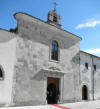

 The outside of the church and convent today.
The outside of the church and convent today.
The order of Capuchins is the strictest of the three orders that trace their
origin to St. Francis. As Francesco knelt at the foot of the altar his jacket
was removed and these words were said: “May the Lord strip from you the old
man.” Than Francesco put on a Franciscan tunic while Padre Tommaso said: “May
the Lord clothe you in the new man.” As he put on the hood the novice master
said: “May the Lord put the hood of salvation upon your head, to defeat the
deceptions of the devil.” As Francesco donned the belt, the master said: “May
the Lord gird you with the cordon of purity and extinguish the fire of lust so
that the virtues of continence and chastity might abide in you.” Then he was
given a lighted candle: “Take the light of Christ as a sign of your
immortality.” After that he received the tonsure as a sign of submission to Christ.
Completing the ceremony he was given a
new name as a sign that he was born a new
man: Pio da Pietrelcina.[10]
Padre Pio recalled in 1922: "Where better I could serve you, o Lord, if not
under the banner of the Poverello (the little poor man) di Assisi."[11]
The novitiate is a yearlong succession of trials intended to put off weak souls.
It is amazing that anybody could survive it. Only with powerful supernatural
help is this possible. Once you survive that year, you can put up with anything.
No hardship will ever again dismay you.[12]

 The choir where Brother Pio and the other novices prayed.
The choir where Brother Pio and the other novices prayed.
During the year of novitiate Francesco Brother Pio distinguished himself for his
obedience, and for spending long hours in prayer. In two occasions he had to
wait for hours in the cold at the door of the master of the novices, without any
complaints.[13]
Once he said: “If my superior ordered me to jump out of the window, I would not
argue. I would jump.”[14]
In the convent there was no central heating. Only on the coldest winter nights
the community could gather before the common fireplace to warm themselves before
retiring. The friars wore sandals but no socks. The novices went barefoot.
[15]
The life in the convent was not for everyone. It was a life of great austerity.
After midnight a bell awakened the community of friars and novices at 12:30 AM
for prayers in the choir, Divine
Office Matins and Lauds. After that, at about 2:00 AM they went back to bed.
They arose again at 5:00 AM: Make the bed and go to choir for: Angelus, Litany
of the Saints, meditation, personal prayers, followed by Mass, Divine Office
Prime and Terce, and a second Community Mass
“Messa Conventuale.” After that there
was breakfast of boiled bread and oil, after which they went back in the choir
for the Divine Office of Our Lady.
The novices had than a conference with the master Padre Tommaso, memorized the
Rule of the Capuchin order, and studied the lives of the saints.


 The refectory for the novices and friars.
The refectory for the novices and friars.
At noon there was lunch. The meals were frugal, chiefly consisting of bread and
stew. During the meals there was no talking. In Lent no meat was served at all,
and on Lenten Fridays they subsisted on brad and water.
 The cooking place at the time of brother Pio
The cooking place at the time of brother Pio 
At 7 PM: Rosary in choir, than 30 minutes of meditation, the Compline (final
hour of the Divine Office), supper at 8 PM followed by a brief period of
recreation.
Finally at 9 PM: 30 minutes visit to the Blessed Sacrament, examination of
conscience, and bedtime.[16]
[17]
On Mondays, Wednesdays, and Fridays the community took the discipline. The
friars and novices went to the choir, pulled the habit from their backs and
struck themselves on the bare flesh with a chain. During the discipline they
were to think of the Passion of Jesus.
[18]
There
was always blood on the floor after these religious exercises.[19]
Padre Tommaso went a step further and he would order the discipline at any time or place, until the back was bleeding. Vincenzo Masone left for good, after two months of this strict discipline. Another novice commented “Back home we pay a dime to see madmen. Here we see them for free.” He too left the friary and never returned.[20]
![]()
![]()
![]()
 The fruit and vegetables garden
The fruit and vegetables garden
One of the novices later testified about Padre Pio: “He never criticized, never
grumbled about the cold, or the food. What struck me most was his love for
prayer.” And a friar recalled of him: “He would weep many tears, so much that
very often the floor would be stained.”[21]
[22]




 Brother Pio's room in Morcone.
Brother Pio's room in Morcone.
Padre Pio’s mom visited her son during the novitiate, and brought him a number
of goodies from home. When he saw her he sat a few feet away, with his hand in
the sleeves, and his eyes lowered. She was horrified that her son was not
showing any sign of affection, and returned in tears to Pietrelcina. In later
years Padre Pio recalled: “As soon as I saw my mother, my impulse was to throw
myself into her arms. But the discipline of the novitiate did not permit this.”
[23]
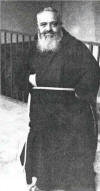 Padre Angelico da Sarno recalling the time spent in the
novitiate.
Padre Angelico da Sarno recalling the time spent in the
novitiate.
October 1903 brother Pio got the assignment of tutoring a new novice in the
religious life. The novice, future Padre Angelico da Sarno recalled: “For three
months, Pio every day explained to me the rules and constitutions. Every day I
was longing for this encounter. He was only few months older than me.”
At the end of the yearlong novitiate, on Friday January 2, 1904, he pronounced
the temporary wows of chastity, poverty and obedience. He knelt before the
provincial Padre Pio da Benevento, and declared: “I, Fra Pio da Pietrelcina, wow
and promise to the Omnipotent God, to the Blessed Virgin Mary, to St. Francis,
and to all the saints, and to you, father, to observe for three years the Rule
of the Friars Minor, confirmed by Pope Honorius, living in obedience, without
property, and in chastity.”[24]
His
mom was there: "My son, now you really are a son of Saint Francis. May he bless
you."[25]
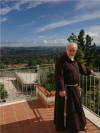 Padre Eliseo Pizzarelli kindly, patiently, and
knowledgeably showing around the convent.
Padre Eliseo Pizzarelli kindly, patiently, and
knowledgeably showing around the convent.
Fra’ Pio stayed in Morcone from January 6, 1903, until February 24, 1904. Six
years of study for the priesthood were waiting for him.
 Panorama from the convent in Morcone.
Panorama from the convent in Morcone.
Padre Pio has been to Morcone severar other times. He returned to Morcone to be
ordained deacon on July 18, 1909. On July 21, 1910 he went to Morcone to learn
how to say Mass. After a day he felt sick and returned to Pietrelcina were don
Salvatore Pannullo thought him the ceremonies of Mass.[26]
Padre Pio was again in Morcone in December 1913, by suggestion of the Capuchin
provincial father, but after five days he felt sick and had to return to
Pietrelcina.[27]
 The convent in the old days.
The convent in the old days.
 Map of the area. The star indicates sant'Elia.
Map of the area. The star indicates sant'Elia.
![]() Panorama of the church and convent.
Panorama of the church and convent.
 Outside of the church.
Outside of the church.
High school
On February 25, 1904 the future Padre Pio with his novitiate companions, Brother
Anastasio da Roio and the Provincial Padre Pio da Benevento, moved to the
convent of Sant’Elia a Pianisi. There he began high school, including courses in
rhetoric and philosophy. He stayed there for almost four years, except for a
trip to Campobasso and a brief stay in San Marco la Catola. In Sant’Elia he did
high school studies and learned
Latin.[28]
Dog devil

 Brothe Pio's room in Sant'Elia.
Brothe Pio's room in Sant'Elia.
In Sant”Elia he was favored by “celestial visions”.[29]
At the same time “the martyrdom of the scruples, started at eighteen in
Sant’Elia and continued until twenty one.” He reported it under obedience to
Padre Agostino, in a letter on October 17, 1915.[30]
“During the first two years this trial became almost unbearable. It started in
Sant’Elia and continued later on in San Marco and elsewhere.”[31]
There he saw the devil coming in his cell. He reported in a letter: “He was in
the form of an enormous dog, with a lot of smoke coming out of his mouth, and
the dog talked and said: ‘It’s him, it’s him.’ He had a strong smell of sulphur.
The horrible animal leaped out of the window, jumped on the roof of the nearby
building, and disappeared.”[32]
[33]
[34]
Giovanna Rizzani
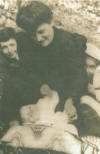 New born Giovanna Rizzani.
New born Giovanna Rizzani.
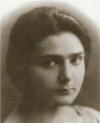 Giovanna at the time when she met Padre Pio.
Giovanna at the time when she met Padre Pio.
Still in Sant’Elia, on January 18, 1905 he experiences the first bilocation. The
details regarding Giovanna Rizzani are reported in the section of bilocation.
[35]
Tears
 Brother Leone with Padre Pio in later years.
Brother Leone with Padre Pio in later years.
Brother Leo (Fra' Leone) classmate of Padre Pio 1903-8, testified: "While
praying, Padre Pio was always crying, silently, and so abundantly that his tears
were leaving traces on the stone pavement of the choir. We youngsters made fun
of him. So he took the habit of lying on the floor hi large handkerchief in
front of him. After praying he would take the handkerchief that was all wet. You
could have squeezed it!"[36]
[37]
Padre Damaso da Sant’Elia a Pianisi gave a similar testimony.[38]
Padre Antonio da San Giovanni Rotondo, reported the same, and when he asked
Brother Pio why was he crying, the answer was: “I cry for my sins and those of
mankind.”[39]
Example
Padre Pietro da Ischitella testified in 1921: “I remember that whenever there
was a procession in Sant’Elia a Pianisi, people were attracted by the collected
bearing of this young man, who distinguished himself from his companions by his
modesty, his eyes.”[40]
Missions
While he was a philosophy student in Sant’Elia, Fra Pio asked to be sent on the
missions. He was denied because he was still a student. He returned on the
subject as soon as he became a priest.[41]
Campobasso
![]()
![]()
![]()
![]()
 Outside of Santa Maria del Monte
Outside of Santa Maria del Monte
In May of 1905 he went with other students fron Sant’Elia to Campobasso, to visit the sanctuary of Santa Maria al Monte.
 Inside of the church.
Inside of the church.

 The castle on the hill.
The castle on the hill.
There he helped
with the religious celebrations.[42]
[43]
 The painting of Amedeo Trevisonno
The painting of Amedeo Trevisonno
![]() Plaque remembering Padre Pio
Plaque remembering Padre Pio
He returned briefly for few days to Campobasso in October 1909. He was already
in Morcone on October 4.[44]
Padre Pellegrino da Sant'Elia a Pianisi, who had been at the side of Padre Pio
during his last hours of life, reported that Padre Pio had told him that the
"Madonna di Santa Maria a Monte" had appeared to him several times. Padre
Pellegrino then asked the artist Amadeo Trivisonno to put in painting what Padre
Pio had described to him. Trivisonno made the painting in 1972. The painting is
above the altar in the room used by Padre Pio while in Campobasso.[45]

 View of San Marco La Catola with map of the area.
View of San Marco La Catola with map of the area.
Philosophy
In October 1905 the convent of Sant’Elia a Pianisi had to be temporarily
abandoned to allow a substantial remodeling of the church and the convent.
Brother Pio had completed the course of rhetoric and passed the exam of
philosophy.[46]
Everybody moved to San Marco La Catola. He remained there until April 1906
studying philosophy. He met there
Padre Benedetto who would become his spiritual director until 1922.[47]
![]()
![]()
![]() Panorama with the church and the convent.
Panorama with the church and the convent.
Tears
Padre Antonino testified: “In Sant’Elia a Pianisi, at the time of the common
prayers, and especially after Communion, brother Pio shed so many tears that
made a little pit in the pavement. We asked him for the reason, and he never
told us. One day, since I was his spiritual director, I asked him under
obedience, and he said: “I cry for my sins, and the sins of everybody.”[48]
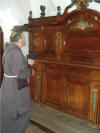


 Padre Pio Capuano describing the life in the convent.
Padre Pio Capuano describing the life in the convent.
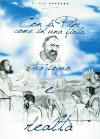 The amazing book on Padre Pio da Pietrelcina written by
Padre Pio Capuano.
The amazing book on Padre Pio da Pietrelcina written by
Padre Pio Capuano.
Padre Pio returned to San Marco La Catola for a month, in 1918, to get spiritual
direction from Padre Benedetto. In his cell #20 Padre Pio wrote eight letters
from April 17 to May 13, 1918, to Padre Agostino and to spiritual daughters.[49]
During that time he continued to be
tormented by scruples about his inadequacy to love God and to help others.[50]
[51]
[52]
[53]
Sant”Elia,
2
In April 1906, brother Pio returned to
Sant’Elia a Pianisi, since the remodeling had been completed.[54]
At that time he predicted the reopening of the convent of San Giovanni Rotondo,
closed in 1896. He also predicted that he would be assigned to that convent. The
convent was effectively reopened in 1909, and Padre Pio moved there in 1916.[55]
At the same time Lucia Fiorentino, a future spiritual daughter of Padre Pio,
wrote in her diary of a vision of a big
tree that would be planted in the convent of San Giovanni Rotondo. A tree whose
shade would cover the entire world.[56]
[57]
Perpetual wows
On Sunday January 27, 1907 Padre Pio made the solemn profession of his perpetual
wows of poverty, chastity, and obedience, in the hands of Padre Raffaele da San
Giovanni Rotondo.[58]
His statement in writing is kept in the registry of the convent.[59]
 The mountaintop town.
The mountaintop town.
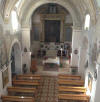
 The church of the convent.
The church of the convent.

![]()
![]()
 Chapel of Padre Pio, with Padre Antonio Belpiede.
Chapel of Padre Pio, with Padre Antonio Belpiede.
The pictures remind of an episode in the fall of 1907 when Padre Pio was student in Serracapriola. The friars were stomping on the fermenting grapes and the fumes were inadvertently inhaled by the future Padre Pio and he got inebriated. Later he used to say that he got drunk without drinking a single drop of wine. Padre Antonio Belpiede extremely kind, patient, and knowledgeable Capuchin friar.

 Brother Pio's room
Brother Pio's room
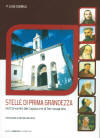 A book about the past friars living in the convent.
A book about the past friars living in the convent.
Theology
At the end of October 1907 Brother Pio was transferred to the convent of
Serracapriola and admitted to the course of theology, under the guidance of
Padre Benedetto di San Marco in Lamis. Brother Pio had complete the course in
philosophy but never took the exam.[60]
The future Padre Pio left Serracapriola in November 1908.[61]
In the fall of 1907, when Padre Pio was student in Serracapriola, the friars
were stomping on the fermenting grapes and the fumes were inadvertently inhaled
by the future Padre Pio and he got inebriated. Later he used to say that he got
drunk without drinking a single drop of wine.
[62]
![]()
![]()
![]()
![]() The mountaintop town of Montefusco.
The mountaintop town of Montefusco.
Theology
Brother Pio arrived in Montefusco at
the end of November 1908, to continue the studies of theology in preparation for
the ordination to priesthood.

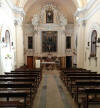
 Outside and inside the convent.
Outside and inside the convent. 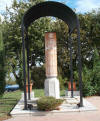
![]() Monument.
Monument.
He stayed there only few months because he was ill and had to return to
Pietrelcina, accompanied by Padre Agostino. Brother Pio left the convent of
Montefusco for his home Pietrelcina in May 1909, accompanied by Padre Agostino,
in the hope that in Pietrelcina he would recover.[63]
Padre Pio later recalled: “The main problem with my sickness was that I did not
appear sick, and many could doubt that I was effectively suffering.”[64]
Aunt Daria
One special episode occurred while brother Pio was in Montefusco in 1908. One
day he gathered chestnuts growing in a nearby forest into a bag and sent the bag
to Pietrelcina to his aunt Daria. She always had a great affection for him. The
woman received and ate the chestnuts. She saved the bag as a souvenir. A few
days later she was looking for something in a drawer where her husband usually
kept the gun powder. It was in the evening so she used a candle to light up the
room when suddenly the drawer caught on fire, and aunt Daria’s face and hair got
burned. After a moment, she took the bag father Pio sent and put it on her face.
Immediately, her pain disappeared and no wound or hair loss or burn mark
remained on her face.[65]

In Pietrelcina Brother Pio felt better but still had bouts of high temperature,
chest pains and stomac upsets that forced him in bed. At the same time continued
to be tormented by the idea that he had not properly confessed his past sins and
should stop the daily communion because of it. He had to be continually
reassured by Padre Benedetto.[66]
During that uneasy time in Pietrelcina he tried to continue the studies for
ordination to priesthood. Don Salvatore Pannullo thought him liturgical
ceremonies, and Don Giuseppe Orlando, the pastor of the parish, thought him
dogmatic theology to prepare him for ordination.
He stayed home almost seven years.[67]


 The mountaintop town of Gesualdo as it was and as it is.
The mountaintop town of Gesualdo as it was and as it is.
 Map of the area. Gesualdo is indicated by a star.
Map of the area. Gesualdo is indicated by a star.
Theology
Between the months of November and December 1909 he spent few weeks in the
convent of Gesualdo where he studied moral theology. In Gesualdo the devil
appeared to Padre Pio in the form of Padre Agostino and tried to discourage him
from continuing the religious life. Padre Pio was disconcerted, and at the
moment he started to understand he said: “Whoever you are repeat after me ‘Long
live Jesus’. The visitor disappeared in a cloud of smoke living behind a
disgusting stench.[68]
Minor Orders
On December 19, 1908 Padre Pio received in the cathedral of Benevento, by the
Archbishop Benedetto Bonazzi, the four minor orders of Doorkeeper, Reader,
Exorcist, and Acolyte. Two days later, on December 21, 1908 in the same
cathedral of Benevento, Mons. Paolo Schinosi, archbishop titular of
Marcianopolis, conferred him the Subdeaconate.
Benevento:
Ordination to Priesthood
 Certificate of ordination to Deaconate
Certificate of ordination to Deaconate
On Sunday July 18, 1909 Brother Pio was ordered Deacon by Mons. Benedetto Maria
Della Camera, titular bishop of Thermopolis, in the church of the convent in
Morcone.[69]
Too much salt
 Inside of the church were Padre Pio baptized Ermelindo Masone.
Inside of the church were Padre Pio baptized Ermelindo Masone.
At the time when Padre Pio was a deacon (July 18, 1909 – August 10, 1910), while
in Pietrelcina, he was asked by Vincenzo Masone to baptized his newborn child.
Whith the permission from archpriest Pannullo he did. At a certain point of the
ceremony he had to put a very small pinch of salt in the mouth of the baby.
Apparently he used too much salt, and the baby’s eyes started rolling. Padre Pio
was frightened and run to Pannullo: “I killed the baby! I killed the baby!” But
it was not the case. The newly baptized became the redemptorist religious Padre
Ermelindo.[70]
Age dispensation
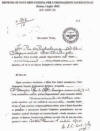 The certificate of age dispensation.
The certificate of age dispensation.
The minimal canonical age to be ordained priest is to have completed 24 years.
Padre Pio was in poor health and fearful he could die soon. So he asked for
dispensation to be ordained at 23. On January 22, 1910, he wrote a letter to
Padre Benedetto, provincial minister, begging him to petition the Holy See and
recommend favorably for the dispensation: “…explaining the current status of my
health … so that if God has decided to abbreviate my exile on earth, I will die
very happy.”[71]
On July 6, 1910 Padre Benedetto informed Padre Pio that the Holy See had granted
the dispensation.[72]
On July 30, 1910, together with don Salvatore Pannullo who had been preparing
him privately, Brother Pio went to the Archibishop of Benevento to take the
exams. The committee was happy with his preparedness, and gave the go ahead for
him to be ordained priest.[73]
 Certificate of ordination of Padre Pio to priesthood by Mons. Schinosi.
Certificate of ordination of Padre Pio to priesthood by Mons. Schinosi.
On August 10, 1910, at age 23, he was ordained priest in the Cathedral of
Benevento. He was the only priest ordained that day in a private ceremony in the
chapel of the canons, by Mons. Paolo Schinosi, titular Archbishop of
Marcianopoli.[74]
Prayer card
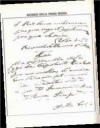 Draft by Padre Pio for the prayer card of his ordination.
Draft by Padre Pio for the prayer card of his ordination.
Padre Pio wrote on the prayer card for his ordination to priesthood:
O king, I ask that my life be spared,
and I beg that you spare the lives of my people.”
Esther 7:3
Souvenir of my first Mass.
"Jesus,
my sigh and my life,
today that with trepidation
I raise You in a mystery of love,
may I be for the world
Way, Truth and Life,
and for You holy priest
perfect victim.
P.Pio, Capp.”[75]
In the afternoon of the same day Padre Pio and his mom returned to Pietrelcina.
They were met on the edge of town by the city band. The band accompanied them
home greated by cheering townspeople along the way. At the house Mamma Peppa put
on a great feast.[76]

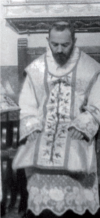 First solemn Mass in St. Mary of the Angels in Pietrelcina.
First solemn Mass in St. Mary of the Angels in Pietrelcina.
On August 14, 1910 he celebrated his 'First Solemn Mass in the parish church of
Our Lady of the Angels in Pietrelcina'. Padre Agostino said in the sermon: “You
are in poor health so you can’t be a preacher. I wish you to be a great
confessor.”[77]
[78]
Padre Pio was approved for confessions by the archdiocese of Benevento after his
ordination to priesthood, but for three years hid didn’t confess, by disposition
of Padre Benedetto.[79]
Padre Pio obtained the license to confess in May 1914.[80]
Padre Pio started his ministry officiating in St. Anna, the church where he had
been baptized, helping the archpriest Salvatore Pannullo with baptisms,
weddings, funerals and Masses.[81]
After Mass he used to go to Piana Romana, in the Forgione farm. There his father
had built a straw hut, under an elm tree. Near the hut and the elm there were
two large stones. He used to call the stones “il seggiolone” the big chair. In
that setting he spent many hours a day, praying, reading and meditating. “From
there I used to see the sunrise and the sunset.”
[82]
To go to Piana Romana from Rione Castello where he lived Padre Pio had to walk
over a little bridge. There invariably he met a bunch of devils who would say
“Mo’ passa o’ santariello (Here is the little saint passing). Padre Pio’s reply
was: “Schiattate! Schiattate!” (Burst! Burst!) A sign with explanation reminds
the events.[83]
The remnants of the elm tree, in the chapel built around the stump.
On September 7, 1910, twenty eight days after being ordained priest, while he
was praying in Piana Romana, on the “Masseria” ground, under the elm tree, Jesus
and Mary appeared to him and gave him the wounds.[84]
His mom was not far, in the Masseria, and when Padre Pio showed up, a bit later
than usual, the mother noticed that he was shaking his hands like they were
burning. The mom told him: “Why are you shaking your hands, are you learning to
play guitar?” Padre Pio did not answer.[85]
Salvatore Pannullo, pastor of the Parish in Pietrelcina testified that in that
afternoon of September 7, 1910 Padre Pio showed him the wounds and told him:
"Father, do me a favor. Ask Jesus to take them away. I want to suffer, to die
from suffering, but in secret." They prayed together, and God answered their
prayer. The wounds disappeared while the suffering continued. When Pannullo was
told in 1918 that the wounds had appeared on Padre Pio, he replied: You see them
now. I saw them in 1910."
[86]
[87]
Pannullo insisted that Padre Pio saw a doctor. The first doctor diagnosed as
tuberculosis of the skin. Then they went to dr. Andrea Cardone. Cardone was
positive that they were not of tubercular origin, but he could not explain them.[88]
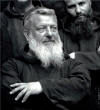
Padre Pio did not tell anybody of the wounds, besides Pannullo, for a full year.
He reported the phenomenon a year later, in a letter to Padre Benedetto dated
September 8, 1911. In the letter he stated that he hadn’t said anything because
he was “ashamed”. Here are his words: “Last night in the middle of the palm of
my hands appeared a circular red mark, accompanied by strong sharp pain. The
pain was stronger on the left hand. Also under the feet I feel pain. This
phenomenon has been going on for about a year. But it had been a while since it
happened last time. Don’t get agitated because this is the first time that I
tell you about it. You know that shame took over me. Even now you can’t imagine
how much violence I have had to to do myself to tell you about it.”
[89]
On October 10, 1915, answering a specific question by Padre Agostino, asking if
he had received the wounds in 1910: “Yes, I received the stigmata. I was aghast.
They were visible, especially in one hand, and prayed the Lord to remove this
visible sign, and they disappeared. But the sharp pain did not go away.”[90]
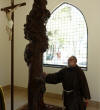
 Years later Silvio Scocca, the son of Mercurio, childhood friend of Padre Pio,
was asked to take care of the Forgione’s farm. He didn’t know about the
‘Seggiolone’. He saw those two large stones and tried to remove them, to no
avail. One day he was visiting Padre Pio in San Giovanni Rotondo and he told
him: “Don’t remove those two stones. The where my seggiolone. From there I used
to see the sunrise and the sunset.”[92]
Years later Silvio Scocca, the son of Mercurio, childhood friend of Padre Pio,
was asked to take care of the Forgione’s farm. He didn’t know about the
‘Seggiolone’. He saw those two large stones and tried to remove them, to no
avail. One day he was visiting Padre Pio in San Giovanni Rotondo and he told
him: “Don’t remove those two stones. The where my seggiolone. From there I used
to see the sunrise and the sunset.”[92]
Padre Pio did not return to the convent because of poor health. He suffered
mysterious illnesses and just his stay in Pietrelcina was mysterious. Padre
Benedetto for five times in the span of two years ordered Padre Pio back in
convent. Padre Pio obeyed promptly, but each time he became so suddenly gravely
ill that they accompanied him precipitously back home.[93]
Padre Agostino wrote that when he questioned him one day about it his answer
was: “I cannot tell you the reason why the Lord wanted me in Pietrelcina. I
would lack of charity!”[94]
From some documents, letters, depositions, testimonies, one might have to
conclude that the life in some convents could not have been that exemplary at
the time.[95]
Padre Pio could not afford climbing the steep steps of “La Torretta”. He moved
to his brother’s home since it was empty. His brother had emigrated to America.
Michele’s home was located above the maternal home of Padre Pio.
Meanwhile the months passed, and the fact that Padre Pio stayed at home instead
of a convent, continued to create agitation in the leadership of the Capuchin
Order. Padre Agostino wrote: “How would I like to see you in the friary!” Padre
Pio answered: “I continue to suffer at home, but I am able to perform my duties.
That is something which was never possible when I lived in community”. And the
Father Provincial stated: “Your continued stay in your home is a source of great
sorrow to me.”[96]
Because of the above, On October 28, 1911, Padre Benedetto took Padre Pio for a
special examination “to hear from the science if he could stay away from his
hometown without complomising his health”.[97]
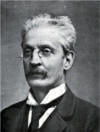 Prof. Dr. Antonio Cardarelli, professor of clinical
pathology in Napoli.
Prof. Dr. Antonio Cardarelli, professor of clinical
pathology in Napoli.
The physical examination was done by the famed Dr. Antonio Cardarelli in Naples.
After a thorough examination Cardarelli suggested to take Padre Pio to the
nearest convent. According to the diagnosis of the celebrated physician, the
young friar's days were numbered,
and he had few days left to live,
and he couldn't travel long distances.[98]
Following the suggestion from dr. Cardarelli. his superior Padre Benedetto
accompanied Padre Pio to the friary of San Nicandro, in
Venafro.[99]
The town of Venafto, the convent and the church of San Nicandro. Map of the area.
Padre Pio stayed in the convent of Venafro from the end of October 1911 until
December 7 of the same year. In Venafro Padre Pio tried to get involved in the
routine of the community life. But he was unable to do it. The days he spent in
Venafro he couldn’t retain any food, and lived only on the daily Eucharist.[100]
The Superior Padre Evangelista took Padre Pio again to Napoli to see another
specialist. Padre Evangelista noted that “these doctors understand very little.”
[101]
Padre Agostino: “The whole thing continued to be a mistery”.[102]


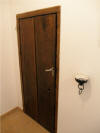

 The cell of Padre Pio in Venafro.
The cell of Padre Pio in Venafro.
During the month and a half stay in the convent of Venafro, while Padre Pio was
sick in bed, unable to retain food, feverish and at times delirious, and “in
danger of death”, Padre Agostino noted by coincidence that something was going
on with Padre Pio. While Padre Agostino was at Padre Pio’s bedside, his face
would have an agitated frightened expression, followed by a serene and cheerful
one; the eye wouldn’t blink, and he would stare at something unseen by others.
Padre Pio begged Padre Agostino not to live him alone, and Padre Agostino
decided to jolt down what he was hearing form Padre Pio’s voice. These notes
later became a diary and give us an unprecedented insight in the relations of
Padre Pio with the unseen. Padre Evangelista, the superior of the convent,
joined Padre Agostino in witnessing the events. The described it to the Dr.
Nicola Lombardi, physician of the friars, and he was witness to two ecstasies on
November 29 and December 3, 1911. He described that Padre Pio had no pupillary
reaction to the light of a match, hearth beat asynchronous from the pulse, the
face appearing “vivacious and beautiful”. Then the doctor followed Padre
Agostino outside the room. Padre Agostino whispered an order to Padre Pio to
return to normalcy, and he instantly obeyed. The doctor was impressed. He gave a
written testimony of the events.[103]
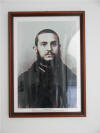
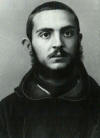 Picture
of Padre Pio done in Venafro when he was told he had
only few days to live.
Picture
of Padre Pio done in Venafro when he was told he had
only few days to live.
Satan would appear in the form of an ugly black cat trying to fling on him, as a
nude woman dancing lewdly, or just spitting on him without appearing, or as is
spiritual father, as his superior, pope Pius X, his guardian angel, St. Francis,
the Virgin Mary, and also as the horrible self, with an army of demonic spirits.
At times there were no apparitions but he was beaten until he bled, tormented
with deafening noises, covered with spit. He was able to free himself from the
torments by asking the apparition to repeat after him: “Long live Jesus.” At
that point the demonic vision would disappear.[104]
Padre Agostino wrote in his diary that frequently, entering in his cell, Padre
Pio asked him to repeat: “Long live Jesus.” Padre Agostino would say: “Long live
Jesus a thousand times.” After that they started their conversation.[105]
Padre Agostino wrote that “the heavenly visions started immediately after the
diabolic ones. He then had long conversations with Jesus, the Virgin Mary, the
Guardian Angel, St. Francis of Assisi, and other saints.”[106]
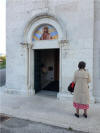
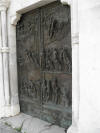

![]()

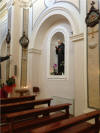
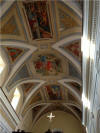



![]()
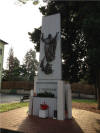
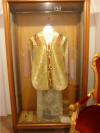
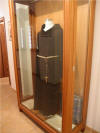

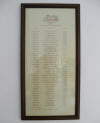

 Inside and outside of the church. Monument to Padre Pio.
Museum.
Inside and outside of the church. Monument to Padre Pio.
Museum.
Pietrelcina




 Padre Pio's room in Pietrelcina.
Padre Pio's room in Pietrelcina.
In Pietrelcina Padre Pio walked with difficulty on the cobblestone pavement of
the streets, because of the invisible wounds on his feet. The archpriest
Salvatore Pannullo decided that on Tuesdays, Thursdays and Fridays, when the
wounds were more painful Padre Pio would celebrate Mass in the church of St.
Anna, close to where he lived. There, in the space in front of the church he
would also sit with the children, teaching them catechism and sacred hymns.[109]
Cobbler
The cobbler in town had a few months old child who was very ill and about to
die. He refused his wife’s pressure to have the child baptized. One day the
mother with other relative took the dying child to Padre Pio, and the child was
baptized. When the cobbler father knew about it, went to threaten Padre Pio:
“You put water on my child and said that with this water he will recover. If he
dies will be your fault.” Padre Pio was scared and started praying locked at
home, and frequently coming to the window, asking how the child was doing. The
child started improving and recovered.[110]
Dispensations
Because of his poor sight, with a Decree from The Sacred Congregation of
Religious on March 21, 1012, he obtained the faculty to celebrate the votive
Mass of the Virgin Mary on holy days, and the Mass for the deceased on ferial
days. The faculty was for three years, renewable.[111]
For the same reason and on the same date he received the faculty to recite daily
fifteen decades of the Rosary instead of the Divine Office.[112]
About Padre Pio’s Mass, Don Giuseppe Orlando, a priest in the same church, gave
a written testimony that “the Masses were too long” “the ‘memento’ (‘remember’)
would last for an hour” and the farmers that came to mass before going to the
field complained that they couldn’t spend many hours praying with him instead of
going to work .[113]
[114]
The pastor talked to Padre Pio’s Capuchin superior, and got a suggestion that
worked well. “The pastor would stay in the church when Padre Pio was
celebrating, and when he started slowing down, he would give him a mental order
to go on. In the name of obedience
he resumed Mass right away.”
[115]
[116]
While in Pietrelcina (mid May 1909 – March 17, 1916) the archpriest Salvatore
Pannullo, following the suggestion by Padre Agostino Daniele, would from afar
mentally order Padre Pio to resume Mass, and he would promptly obey.[117]
After Mass Padre Pio would stay for hours for thanksgiving in the back of the
main altar of the church of St. Mary of the Angels in Pietrelcina. Many times he
would stay still in ecstasy, appearing like dead, scaring the sacristan Michele
Pilla. Pilla used to call the archpriest Pannullo, and he would come, and
whisper and order to return to senses in Padre Pio’s ear, and he would do it on
the spot.[118]
Secularization
Since Padre Pio, because of his poor health was unable to reenter in convent,
the superior general on the Capuchins, Padre Pacifico da Seggiano, asked of a
decree of secularization, were Padre Pio would be removed from the Capuchin
order and incardinated as a priest in the dioceses of Benevento. In a vision
Padre Pio complained with St. Francis: “My father, are you chasing me away from
your Order? Let me die, instead.” St. Francis promised that he would not be
expelled from the Order.
Rescript
 Rescript dated February 25, 1915 were Padre Pio is
dispensed from residing in convent.
Rescript dated February 25, 1915 were Padre Pio is
dispensed from residing in convent.
The decree of secularization needed several steps, including the approval from
the archbishop of Benevento. In the end it was never obtained. Instead, Pope
Benedict XV, in a rescript from the Congregation for Religious life on February
15, 1915, gave permission to Padre Pio to live outside the convent while keeping
the religious habit, “until the present need persists”.
[119]
[120]
[121]
Foggia
 The Capuchin convent of St. Anna in Foggia.
The Capuchin convent of St. Anna in Foggia.
On February 17, 1916 Padre Pio, having agreed with the request of Padre Agostino
to assist the dying noblewoman Raffaelina Cerase in Foggia, left Pietrelcina and
reached the convent of St. Anna in Foggia. He thought that he would stay there
only few days; instead he remained for about six months, until September 4,
1916.[122]
San Giovanni Rotondo
On September 4, 1916 Padre Pio left Foggia for San Giovanni Rotondo.[123]
The convent would be his permanent home for next 52 years, except for the stint
in military service, until his death.[124]
Bibliography
Agostino, d. S. (2012). Diario. San Giovanni
Rotondo: Edizioni Padre Pio.
Capuano, P. (2012). Con p. Pio: come in una
fiaba. Foggia: Grafiche Grilli. Cap12
Castelli, F. (2011). Padre Pio under
investigation. The secret Vatican files. San Francisco: Ignatius Press.
Cas11
Cataneo, P. (1991). Padre Pio gleanings.
Editions Paulines Quebec. Cat91
Chiocchi Luciano e Frescobaldo Cirri. (1967).
Padre Pio, storia di una vittima. Roma. Chi67
Chiron, Y. (1999). Padre Pio. Una strada di
misericordia. Milano: Figlie di San Paolo. Chi99
Convento. (2001). Padre Pio dalla Terra al Cielo.
San Giovanni Rotondo: Edizioni Frati Cappuccini. Con01
Covino, P. P. (2007). Ricordi e testimonianze.
San Giovanni Rotondo: Edizioni Padre Pio. Cov07
Duchess Suzanne, o. S. (1983). Magic of a Mistic.
Stories of Padre Pio. New York: Clarkson N. Potter. Duc83
Giannuzzo, E. (2012). San Pio da Pietrelcina. Il
travagliato persorso della sua vita terrena. Book sprint edizioni. Gia12
Ingoldsby, M. (1978). Padre Pio. His Life and
Mission. Dublin: Veritas Publications. Ing78
Leone, G. (1976). Padre Pio, infanzia e prima
giovinezza. San Giovanni Rotondo: Edizioni Padre Pio. Leo76
Malatesta, E. (1999). La vera storia di Padre
Pio. Casale Monferrato: PIEMME. Mal99
Peroni, L. (2002). Padre Pio da Pietrelcina.
Borla. Per02
Pietrelcina, P. P. (2011). Epistolario I
Corrispondenza con i direttori spirituali (1910-1922). San Giovanni
Rotondo: Edizioni Padre Pio. Epist. I
Pietrelcina, P. P. (2012). Epistolario III,
corrispondenza con le figlie spirituali (1915-1923). San Giovanni
Rotondo: Edizioni Padre Pio. Epist. III
Preziuso, G. (2000). The life of Padre Pio
between the altar and the confessional. New York: Alba House.
Pre00
Riese, F. d. (2010). Padre Pio da Pietrelcina
crocifisso senza croce. San Giovanni Roronto: Edizioni Padre Pio. Fer10
Ripabottoni, A. d. (1999). Padre Pio così
pregava e insegnava a pregare. Edizioni Paoline. Ale99
Ripabottoni, A. d. (2010). Padre Pio racconta e
dice. San Giovanni Rotondo: Edizioni Padre Pio. Ale10
Ripabottoni, L. d. (1976). Beata te, Pietrelcina.
San Giovanni Rotondo: Edizioni Padre Pio. Ale76
Ruffin, C. B. (1991). Padre Pio: the true story.
Huntington, Indiana: Our Sunday Visitor, Inc. Ruf91
Winowska, M. (1988). Il vero volto di Padre Pio.
Milano: Edizioni San Paolo. Win88
[1] Fer10, 61
[2] Epist. I,
1283
[3] Ale74, 18
[4] Cap12, 90
[5] Gia12, 34
[6] Con01, 46
[7] Ale10, 24
[8] Gia12, 34
[9] Gia12, 34
[10] Ruf91, 46-7
[11] Con01, 50
[12] Duc83, 33
[13] Con01, 53
[14] Ruf91, 51
[15] Ruf91, 48
[16] Gia12, 37-8
[17] Ruf91, 48-9
[18] Ruf91, 51
[19] Duc83, 36
[20] Ruf91, 51-2
[21] Ruf91, 52
[22] Fer10, 63
[23] Rus91, 53
[24] Rus91, 54
[25] Fer10, 66
[26] Con01, 53
[27] Con01, 53
[28] Ing75, 25
[29] Epist. I,
669
[30] Epist. I,
679
[31] Epist. I,
679
[32] Pre98, 54-5
[33] Cataneo,
79-86
[34] Ing78, 26-9
[35] Ing78, 26-9
[36] Win88,
134-5
[37] Ing75, 24
[38] Ale10, 33
[39] Ale10, 33
[40] Cas11, 193
[41] Ing78, 29
[42] Leo76,
145-7
[43] Chi99, 43
[44] Con01, 82
[45] Con01, 82
[46] Ale10, 28
[47] Con01, 91
[48] Ale74, 32
[49] Con01, 93
[50] Epist, III,
724
[51] Epist. III,
855
[52] Epist. III,
951
[53] Epist. I,
1025
[54] Chi99, 45
[55] Chi99, 45
[56] Chi99, 45
[57] Cov07, 25-6
[58] Ale10, 28
[59] Chi67, vol.
III, 14
[60] Ale10, 30
[61] Con01, 102
[62] Pre98, 59
[63] Con01, 109
[64] Con01, 111
[65] Ruf91, 66
[66] Ale10, 44-5
[67] Ale10, 46
[68] Ale11, 72
[69] Pio12, 10
[70] Cap12, 79
[71] Epist. I,
178-9
[72] Epst. I,
188
[73] Ale10, 47
[74] Gia12, 65
[75] Epistolario
I, 196
[76] Ruf91, 73
[77] Leo76, 172
[78] Per02, 116
[79] Ale12, 40
Note
[80] Cap12, 84
[81] Con01, 127
[82] Con01, 7
[83] Per02, 147
[84] Ruf91, 78-9
[85] Con01, 39
[86] Lin73, 209
[87] Ruf91, 78-9
[88] Ruf91, 79
[89] Epist. I,
234
[90] Epist. I,
669
[91] Con01, 40
[92] Cap12, 101
[93] Per02,
156-7
[94] Fer10, 48
[95] Per02,
156-161
[96] Ale10, 51
[97] Con01, 127
[98] Con01, 127
[99] Mal99, 56
[100] Win88, 54
[101] Ale10, 52
[102] Ago10, 21
[103] Con01,
130-1
[104] Ago12,
50-2
[105] Ago12, 289
[106] Ago12, 290
[107] Con01, 131
[108] Con01, 131
[109] Per02, 134
[110] Per02,
137-8
[111] Ago12, 62
note
[112] Ago12, 62
note
[113] Gia12, 66
[114] Del62, 49
[115] Chi67,
III, 19
[116] Del62,
50-1
[117] Cap12, 78
[118] Cap12,
78-9
[119] Epist. I,
538-9
[120] Per02, 164
[121] Ago12,
61-2
[122] Con01, 141
[123] Con01, 152
[124] Epist. I,
12